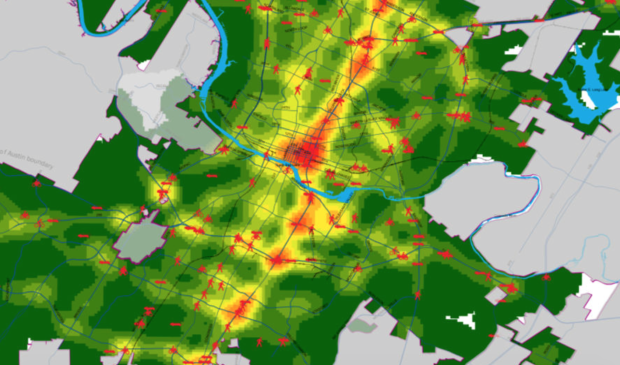City may fix five most dangerous intersections
Tuesday, September 8, 2015 by
Tyler Whitson So far this year, Austin has already had 76 traffic fatalities – 13 more than it did in all of 2014. Now, City Council is considering taking immediate action by funding traffic safety improvements at Austin’s five most dangerous intersections in the forthcoming city budget.
On Sept. 2, Austin Transportation Department staff submitted a budget-question response identifying the five “highest priority, collision prone intersections” in Austin and estimated the cost of making them safer through engineering improvements at about $3.8 million.
Council Member Ann Kitchen, who also chairs the Council Mobility Committee, is leading the way on the effort. She has submitted a budget concept menu item that would provide funding for the projects in the Fiscal Year 2015-16 city budget.
The majority of Council members indicated in a budget poll on Sept. 1 that they are interested in considering the item during the budget adoption process, which begins this morning.
“Our staff has numerous initiatives underway to address traffic fatalities and traffic safety,” Kitchen told the Austin Monitor on Friday. “This particular concept menu item is something that we can do immediately. I think it’s one that a lot of Council members are interested in including.”
Kitchen said she hopes Council will move forward with funding the entire proposal and that she believes it can do so in a way that has a smaller net budget impact by moving existing funds around. “The bottom line is that’s how much it’s going to cost to fix these intersections, and so we’re committed to those dollars – it’s just a matter of where we get them from,” she explained.
In order from highest collision frequency, rate and severity level, the intersections are West Slaughter Lane and Manchaca Road; Lamar Boulevard and Rundberg Lane; Lamar Boulevard and Parmer Lane; U.S. 183 Service Road and Cameron Road; and I-35 Service Road Southbound and Martin Luther King Jr. Boulevard.
Proposed improvements include adding raised medians, modifying turning lanes and, in one case, adding a new lane. The goals include preventing drivers from making unsafe turns, reducing driver speeds, forcing drivers to yield and making crosswalks safer for pedestrians.
“At some locations, collisions are predominantly random and mostly associated with drivers’ errors,” Austin Transportation Department staff wrote. “However, some locations have particular collision patterns that are preventable and can be targeted with engineering countermeasures. ATD is adopting this procedure to target the preventable collisions and improve overall traffic safety in Austin.”
West Slaughter Lane and Manchaca Road – the most dangerous and, at $1.5 million, most expensive intersection that staff has identified – was the scene of a deadly nine-car crash on July 31 in which one person died and five were injured.
“(That intersection has) been on our radar screen,” said Kitchen, “but as an immediate response to the most recent fatality there, staff performed a detailed engineering safety study and identified some things that could be done, and that’s what we’re trying to act on as soon as possible.”
If given funding for the improvements, Transportation Department staff wrote that it would conduct comprehensive studies before and after construction and use the results to help guide future projects at other dangerous intersections.
The proposal comes at a time when the city is seeing a disturbing rise in traffic fatalities, which Transportation Department Assistant Director Jim Dale presented at a Sept. 2 Mobility Committee meeting.
As of Aug. 29, Dale said, 37 drivers, 23 pedestrians, 11 motorcyclists and one bicyclist had died in traffic accidents. Austin’s pedestrian fatalities, he said, are about double the national average.
Impairment, Dale noted, was a contributing factor in 53 percent of driver fatalities – far above the approximately 30 percent state average – along with 41 percent of pedestrian fatalities and 36 percent of motorcycle fatalities.
Dale added that 95 percent of pedestrian fatalities occurred in prohibited areas such as on highways or in the middle of a street block, while 86 percent occurred between 6 p.m. and 6 a.m. and 43 percent involved “transients.”
These figures, culled from Austin Police Department records, don’t include the most recent crash that occurred on Aug. 31 and resulted in four fatalities.
Dale noted that the city has over 40 transportation safety initiatives. Those scheduled for near-term action include the Mayor’s Challenge for Safer People, Safer Streets; the Safety Improvement Plan; the Pedestrian Safety Action Plan; and the Vision Zero Task Force.
The Safety Improvement Plan involves ranking and mapping collision-prone locations, performing engineering safety studies on them, developing plans, pursuing funding, making improvements and then evaluating those improvements. This plan is the basis for Transportation Department staff’s recommendations regarding the five most dangerous intersections.
The Pedestrian Safety Action Plan, Dale said, will come out toward the end of the year.
Dale added that Transportation Department staff has also proposed, in the upcoming budget, a Consolidated Mobility Safety Plan, which involves contracting a consultant to analyze the city’s transportation safety initiatives and develop an overarching framework. If approved – and once the city hires a consultant, Dale added – staff expects the plan to be ready in about 18 months.
The Vision Zero Task Force was initiated by Council last November with the goal of preventing all Austin traffic fatalities. Composed of representatives from the city and various transportation agencies, the task force has met regularly since January and, according to Francis Reilly of the Planning and Zoning Department, will ask for Council approval “some time this winter.”
Draft map of 2010-2014 traffic fatality concentration courtesy of the Austin Transportation Department.
You're a community leader
And we’re honored you look to us for serious, in-depth news. You know a strong community needs local and dedicated watchdog reporting. We’re here for you and that won’t change. Now will you take the powerful next step and support our nonprofit news organization?










